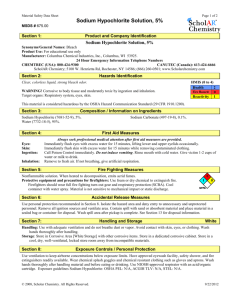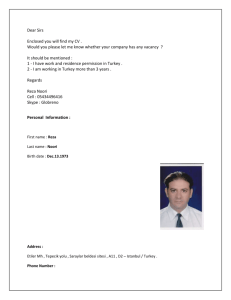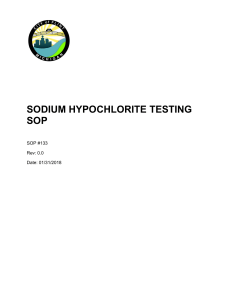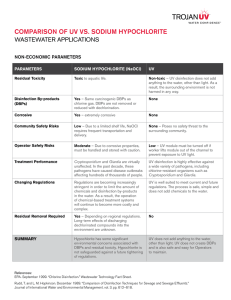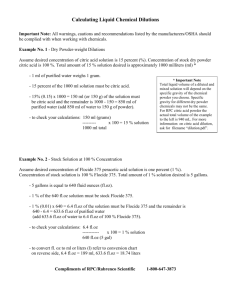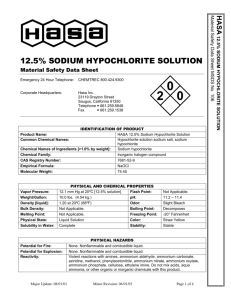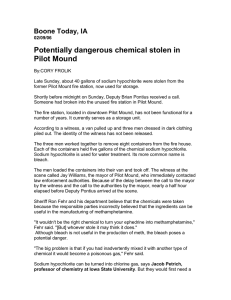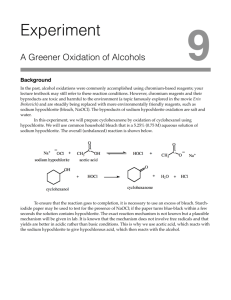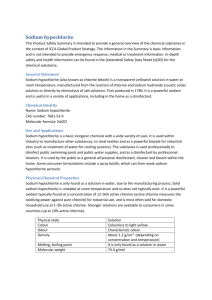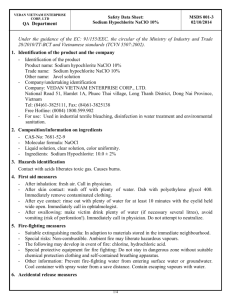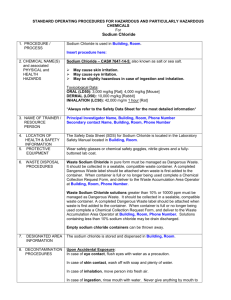Sodium Hypochlorite - WSU Environmental Health & Safety
advertisement
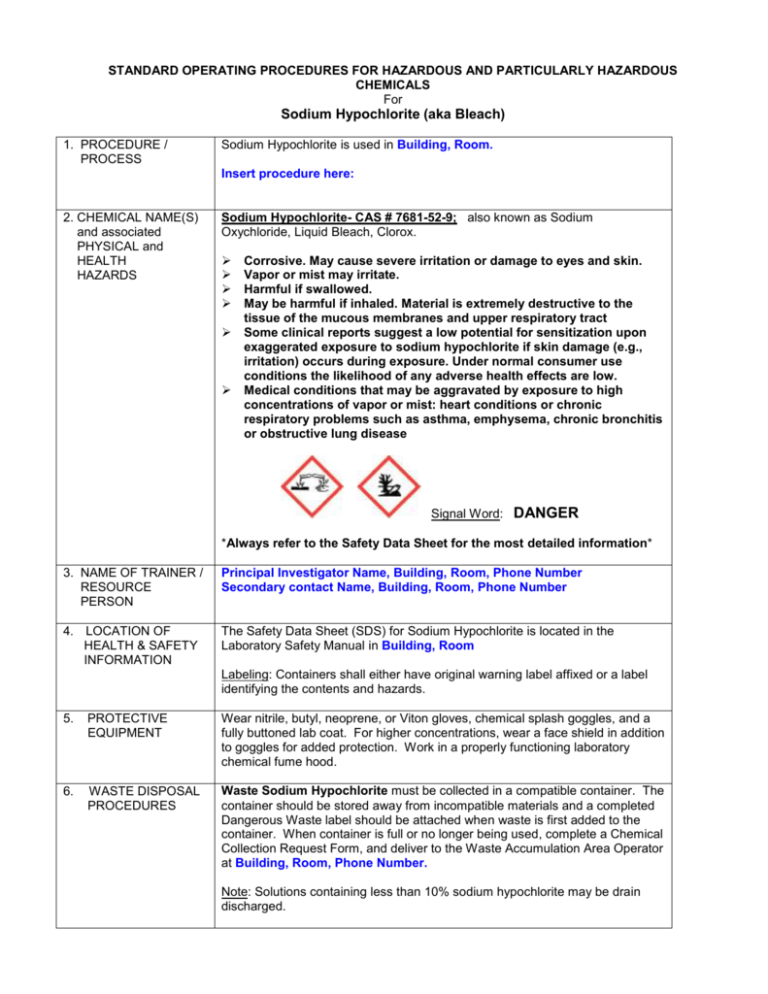
STANDARD OPERATING PROCEDURES FOR HAZARDOUS AND PARTICULARLY HAZARDOUS CHEMICALS For Sodium Hypochlorite (aka Bleach) 1. PROCEDURE / PROCESS Sodium Hypochlorite is used in Building, Room. Insert procedure here: 2. CHEMICAL NAME(S) and associated PHYSICAL and HEALTH HAZARDS Sodium Hypochlorite- CAS # 7681-52-9; also known as Sodium Oxychloride, Liquid Bleach, Clorox. Corrosive. May cause severe irritation or damage to eyes and skin. Vapor or mist may irritate. Harmful if swallowed. May be harmful if inhaled. Material is extremely destructive to the tissue of the mucous membranes and upper respiratory tract Some clinical reports suggest a low potential for sensitization upon exaggerated exposure to sodium hypochlorite if skin damage (e.g., irritation) occurs during exposure. Under normal consumer use conditions the likelihood of any adverse health effects are low. Medical conditions that may be aggravated by exposure to high concentrations of vapor or mist: heart conditions or chronic respiratory problems such as asthma, emphysema, chronic bronchitis or obstructive lung disease Signal Word: DANGER *Always refer to the Safety Data Sheet for the most detailed information* 3. NAME OF TRAINER / RESOURCE PERSON Principal Investigator Name, Building, Room, Phone Number Secondary contact Name, Building, Room, Phone Number 4. LOCATION OF HEALTH & SAFETY INFORMATION The Safety Data Sheet (SDS) for Sodium Hypochlorite is located in the Laboratory Safety Manual in Building, Room Labeling: Containers shall either have original warning label affixed or a label identifying the contents and hazards. 5. PROTECTIVE EQUIPMENT Wear nitrile, butyl, neoprene, or Viton gloves, chemical splash goggles, and a fully buttoned lab coat. For higher concentrations, wear a face shield in addition to goggles for added protection. Work in a properly functioning laboratory chemical fume hood. 6. WASTE DISPOSAL PROCEDURES Waste Sodium Hypochlorite must be collected in a compatible container. The container should be stored away from incompatible materials and a completed Dangerous Waste label should be attached when waste is first added to the container. When container is full or no longer being used, complete a Chemical Collection Request Form, and deliver to the Waste Accumulation Area Operator at Building, Room, Phone Number. Note: Solutions containing less than 10% sodium hypochlorite may be drain discharged. 7. DESIGNATED AREA INFORMATION The Sodium Hypochlorite is stored and dispensed in Building, Room. Work within the confines of a properly functioning, certified laboratory chemical fume hood. The designated area(s) should be shown on the floor plan in Laboratories Chemical Hygiene Plan. 8. DECONTAMINATION PROCEDURES Upon Accidental Exposure: In case of eye contact, flush eyes with copious amounts of water at an emergency eyewash station for at least 15 minutes. Consult a physician. In case of skin contact, flush skin with copious amounts of water for 15 minutes. For exposure over a large portion of the body, remove clothing and shoes and rinse thoroughly in an emergency shower for at least 15 minutes. Consult a physician. In case of inhalation, move person to fresh air and consult a physician. In case of ingestion, immediately seek medical attention and follow instructions on SDS. Upon Accidental Release: Large spill: If a significant amount of sodium hypochlorite is released outside the fume hood, immediately evacuate, secure area and call 911 to contact EH&S. Small Spill: If a small amount of sodium hypochlorite is released (it can be cleaned up in 10 minutes) and you have been appropriately trained to clean it up, you may do so. Trained personnel should wear at the minimum nitrile, butyl, neoprene, or Viton gloves, chemical splash goggles, and a fully-buttoned lab coat. Additional PPE such as respirators may be necessary depending upon material and concentration. (Note: You must be medically cleared, fit tested and enrolled in WSU’s respiratory protection program to wear a respirator). If it is necessary to use a respirator and personnel are not cleared to wear a respirator and not trained to appropriately clean up the spill, the employee should immediately evacuate, secure area, and call 911 to contact EH&S. Absorb with an inert dry material and place material in an appropriate waste disposal container (resealable bag, etc.) and dispose of as hazardous waste (see above WASTE DISPOSAL PROCEDURES). As with all accidents, report any exposure as soon as possible to your Principal Investigator or Supervisor. Additional health and safety information on sodium hypochlorite can be obtained by referring to the SDS or by calling the EH&S Office (335-3041). 9. SPECIAL STORAGE AND HANDLING PROCEDURES Keep container in a cool, dry, and well-ventilated area. Keep container tightly closed and sealed until ready for use. Incompatible with: acids, organic materials, powdered metals, amines, aziridine, methanol, and phenylacetonitrile. Forms shock-sensitive mixtures with certain other materials. Reacts violently with ammonium salts, sometimes resulting in explosions. Reacts with primary aliphatic or aromatic amines to form explosively unstable n-chloroamines. Reaction with formic acid becomes explosive at 55°C Reacts with other household chemicals such as toilet bowl cleaners, rust removers, vinegar, acids or ammonia containing products to produce hazardous gases, such as chlorine and other chlorinated species. Prolonged contact with metal may cause pitting or discoloration. Certification of Hazard Assessment Is this document a certification of Hazard Assessment for the processes identified within? Yes No If yes, provide the name of the person certifying the Hazard Assessment and the date it was performed: ____________________________________________________________________________________ Name Date The location of the Hazard Assessment is indicated in the document preceding this form. Certificate of Employee Training Name of person providing training for employees working with this process: ___________________________________________________________________________________ The following employees have been trained in when, where and how to use selected PPE, the maintenance, limitations and disposal of the PPE selected, and have demonstrated the correct use of the PPE selected on the reverse of this certification. Name Date Trained ________________________________________ _______________________________ ________________________________________ _______________________________ ________________________________________ _______________________________ ________________________________________ _______________________________ ________________________________________ _______________________________ ________________________________________ _______________________________ ________________________________________ _______________________________

